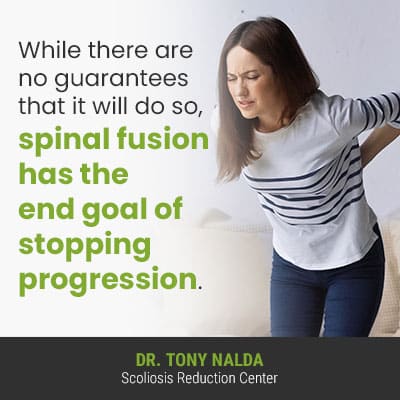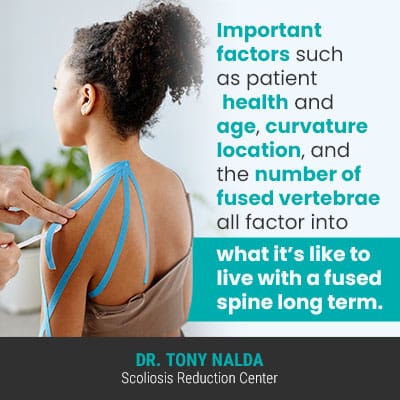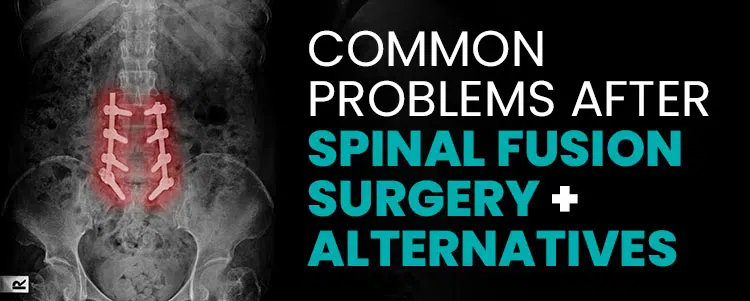All surgeries come with their share of risks, and spinal fusion is no exception. Spinal fusion surgery is a lengthy and costly procedure, and there are also significant non-monetary costs to consider. I encourage all patients, and their families, to educate themselves on other treatment options available so treatment expectations are aligned with the reality of their potential outcomes.
As a structural and progressive spinal condition, scoliosis needs to be treated proactively and effectively. While many people undergoing traditional scoliosis treatment are funneled towards spinal fusion surgery, there are other treatment options available that offer patients different potential outcomes.
There are two main scoliosis treatment approaches, traditional and conservative; the former tends to funnel patients towards spinal fusion surgery, while the latter favors a proactive nonsurgical approach.
What is Spinal Fusion Surgery?
Scoliosis is a structural spinal condition that involves the development of an unnatural sideways spinal curve, with rotation, meaning it doesn’t just bend unnaturally to the side, but also twists from front to back, back to front, making it a 3-dimensional condition.
As a progressive condition, it’s in the very nature of scoliosis to worsen over time, especially if left untreated, or not treated proactively.

While there are no guarantees that it will do so, spinal fusion has the end goal of stopping progression.
Once a condition has progressed to a certain point, on the traditional path of scoliosis treatment, spinal fusion is commonly recommended. This involves fusing the most-tilted vertebrae of the unnatural spinal curve together into one solid bone.
While there are different types of spinal fusion, commonly, the spine is held in place by rods and screws, and the end goal of scoliosis surgery is to eliminate movement (progression) in the fused section of the spine. In some instances, scoliosis surgery is also done with titanium rods.
Also, depending on the spinal section fused, sometimes this involves the removal of its intervertebral discs, and these discs give the spine structure, flexibility, and act as the spine’s shock absorbers, so their removal is not always ideal.
So the condition’s progressive nature is responded to by fusing the most-tilted vertebrae of the spine, at the apex of the scoliotic curve, into one solid bone, and then it’s held in place through artificial means, but this is not the same as actually correcting the curvature itself, which is where nonsurgical corrective treatment options come into play.
But what are the long-term side effects of spinal fusion, and what is it like to live with a fused spine?
Long-Term Side Effects of Spinal Fusion
When it comes to the long-term side effects of spinal fusion and common problems that patients experience post-surgery, the answer will be highly case-specific.
Important factors such as patient health and age, curvature location, and the number of fused vertebrae all factor into what it’s like to live with a fused spine long term.
The reality, however, is that there is a gap in the research/data on long-term results of spinal fusion. By long-term results, I mean 20, 30, or 40+ years down the road; because of that gap, we also don’t know the lifespan of the common hardware used, so that’s another potential issue.
If the hardware starts to fail, a screw comes loose, or a rod deteriorates over time, the only recourse is more surgery and facing the associated costs and risks all over again.
So while the experience of life with a fused spine will be case-specific, there are some common problems many experience, such as a loss of flexibility in the fused section of the spine.
While some people are able to maintain enough flexibility above and below the fused section not to cause many functional deficits, many are disappointed with the loss of spinal flexibility and a decreased range of motion.
When the spine is fused to stop progression, movement in the area is restricted/eliminated, meaning it’s not always possible for patients to participate in the activities they love pre-surgery: activity restrictions can impact the quality of life.

In addition, many report an increase in back pain due to the increased spinal rigidity and the stiff and strained muscles surrounding the fused spinal section.
Due to the spine being held in position, it is also weaker and more prone to injury, which can have a psychological impact as many patients with a fused spine are fearful of trying new things, or returning to their once-loved sports and physical activities.
So while spinal fusion surgery has its place in scoliosis treatment, in addition to the monetary costs of the procedure, there are other important costs to consider in terms of spinal function and quality of life.
Common problems after spinal fusion surgery may include complications related to lumbar lordosis, and especially in cases of severe scoliosis. While spinal fusion is a widely used method for scoliosis correction, understanding the potential challenges and exploring scoliosis treatment options that might serve as alternatives is essential for comprehensive patient care.
As mentioned, there are different approaches to treating scoliosis, and while the traditional approach favors spinal fusion once a curvature progresses past the surgical-level threshold, often at 40+ degrees, there is another scoliosis treatment approach to consider.
Spinal Fusion Alternatives
Here at the Scoliosis Reduction Center®, we favor a nonsurgical conservative, aka functional approach, that strives to preserve as much of the spine’s natural function by working towards corrective results. We always do our best to answer your scoliosis questions and offer conservative treatment alternatives.
As scoliosis is a structural condition, it has to, first and foremost, be impacted on a structural level, and while there are no treatment guarantees, I work towards this by achieving corrective results in the form of a curvature reduction.
Through integrating different forms of treatment, I can impact conditions on multiple levels, and the Center’s results speak for themselves.
As each case is unique and the complex nature of scoliosis necessitates a customized approach, I craft treatment plans around important patient/condition variables such as age, curvature location, condition type (causation), and severity.
By combining condition-specific chiropractic care, in-office therapy, custom-prescribed home exercises, and corrective bracing, I can work towards reducing scoliosis on a structural level, while increasing core strength so the spine has optimal support from its surrounding muscles, and corrective bracing can help augment those results.
In the traditional approach, a patient with mild scoliosis is commonly told to return for periodic assessments of whether or not progression has occurred. As we know, scoliosis is progressive, and every case is almost guaranteed to progress at some point; to me, this is wasting valuable treatment time and allowing an unnatural spinal curve to progress unimpeded.
This is why the traditional approach is often referred to as reactive, while my conservative approach is considered proactive; here at the Center, my patients benefit from treatment started as close to the time of diagnosis as possible.
Through precise chiropractic adjustments, I work towards adjusting the most-tilted vertebrae back into alignment with the rest of the spine, and this is a corrective result that addresses the underlying structural nature of scoliosis, rather than the surgical approach of merely holding the spine in a corrective position, but not actually correcting the curvature itself.
So I caution patients, and their families, to do their own due diligence in ensuring they are not funneled towards spinal fusion surgery, with no awareness of other options because different treatment approaches offer different potential outcomes, and those differences can have life-long effects.
Spinal fusion surgery is a common procedure used to address various spinal conditions, including severe scoliosis, with the primary goals of relieving scoliosis pain, achieving scoliosis correction, and preventing the progression of the spinal deformity. However, like any surgical intervention, it may be associated with certain common problems, such as post-operative pain, limited mobility, or the potential for adjacent segment disease.
Doctors who treat scoliosis specialize in diagnosing and providing comprehensive care for individuals with spinal curvature disorders, offering various treatment options to help manage the condition.
It’s essential for individuals considering spinal fusion surgery to thoroughly discuss the procedure’s benefits and risks with their healthcare provider. In some cases, there may be alternative treatments or interventions to explore, depending on the specific circumstances, which can offer relief from scoliosis and its associated issues while avoiding the challenges of surgery.
Conclusion
So when it comes to common problems after spinal fusion surgery, while each patient will have their own unique experience, increased back pain, a loss of spinal flexibility, and a spine that’s more vulnerable to injury are among the most common.
Moderate scoliosis, straight-back syndrome and neuromuscular scoliosis may pose challenges for individuals undergoing spinal fusion surgery, necessitating careful consideration of alternative treatment options to address postoperative complications effectively.
As there are two main treatment approaches for patients to choose between, traditional and conservative, I’m open to discussing the differences with patients, and their families, to ensure that treatment expectations are aligned with the reality of their potential outcomes.
Just as all surgeries come with their share of risks, spinal fusion is no exception, and while spinal surgeons have their patients’ best interests at heart, the procedure itself is associated with risks, not to mention potential long-term effects.
Here at the Scoliosis Reduction Center®, I have dedicated my career to rewriting the narrative surrounding scoliosis, and a large part of that is spreading awareness that spinal fusion surgery is neither the only, nor the best, option in many cases.
Through proactive treatment that integrates multiple treatment disciplines, I can help patients achieve corrective results that preserve as much of the spine’s natural function as possible, and by doing so, a certain quality of life is possible to maintain throughout treatment and beyond.
If you, or someone you care about, is facing a scoliosis diagnosis, the next step is committing to a treatment approach that can offer the type of results they’re looking for, so don’t hesitate to reach out to us here for guidance on all treatment options available.





